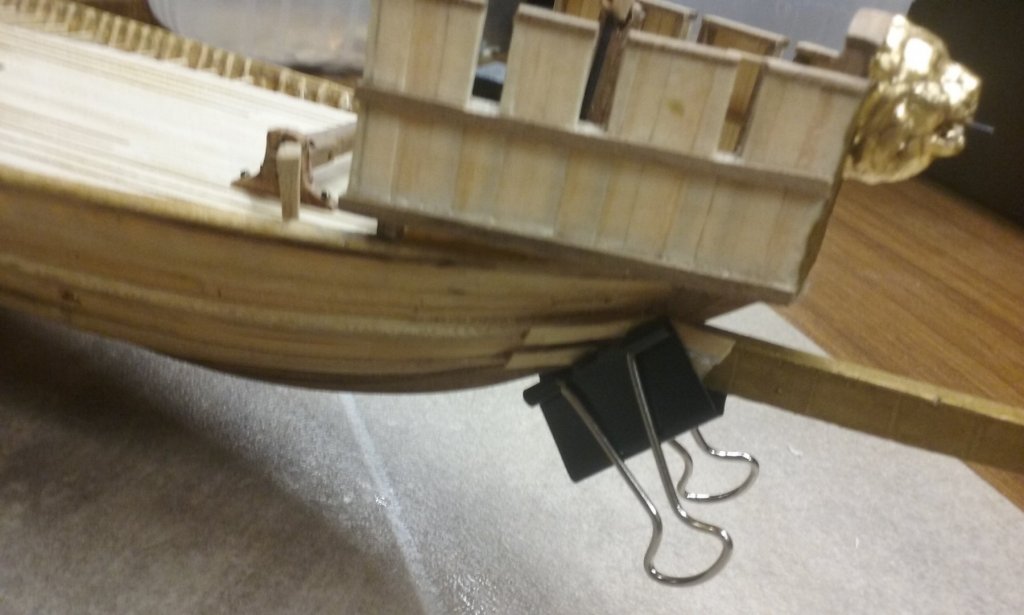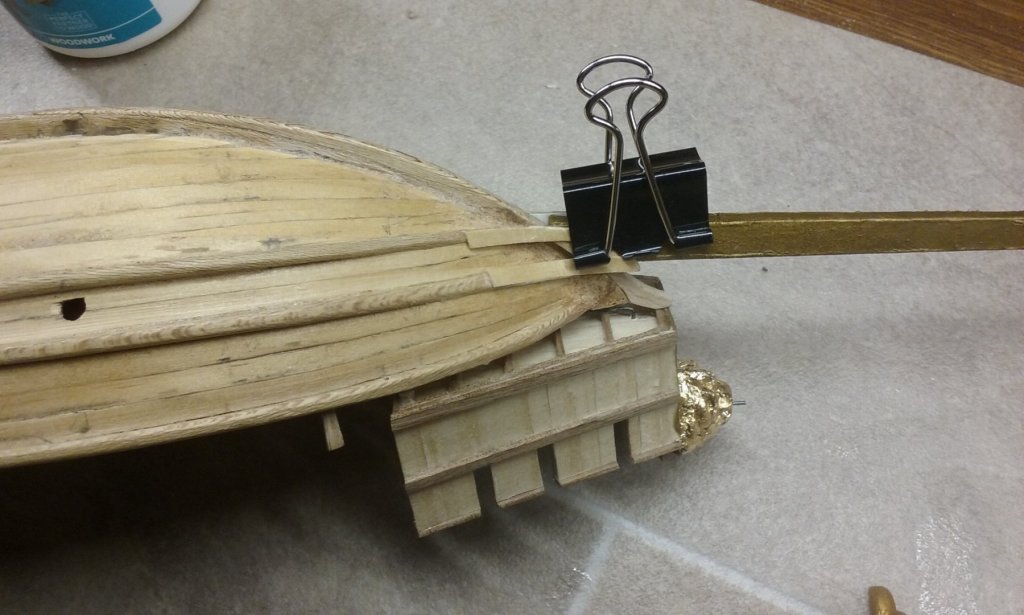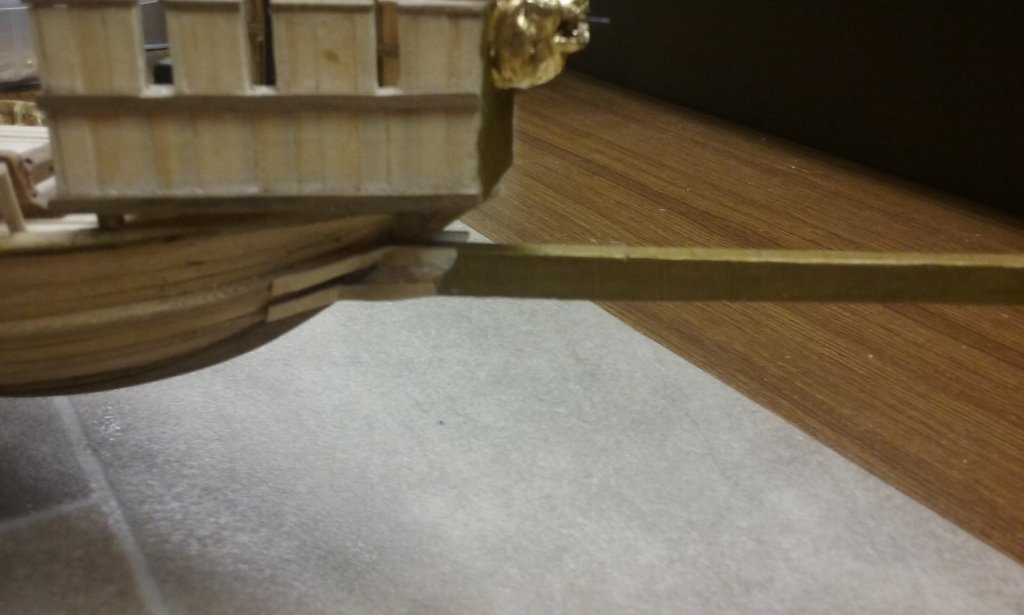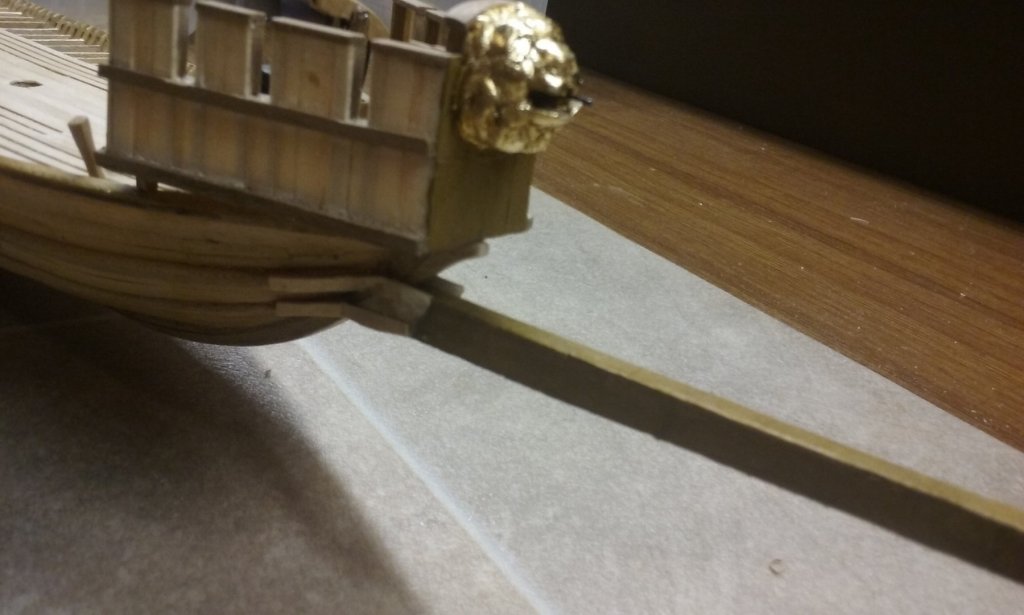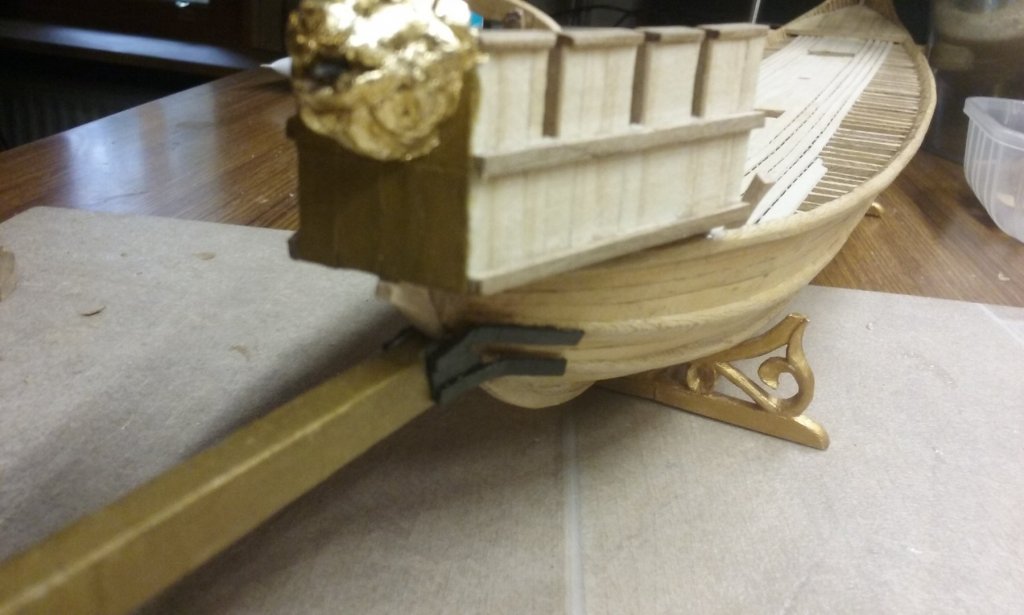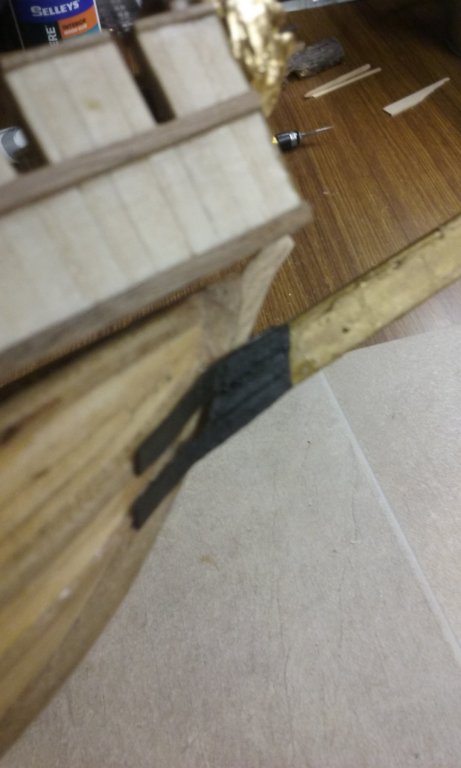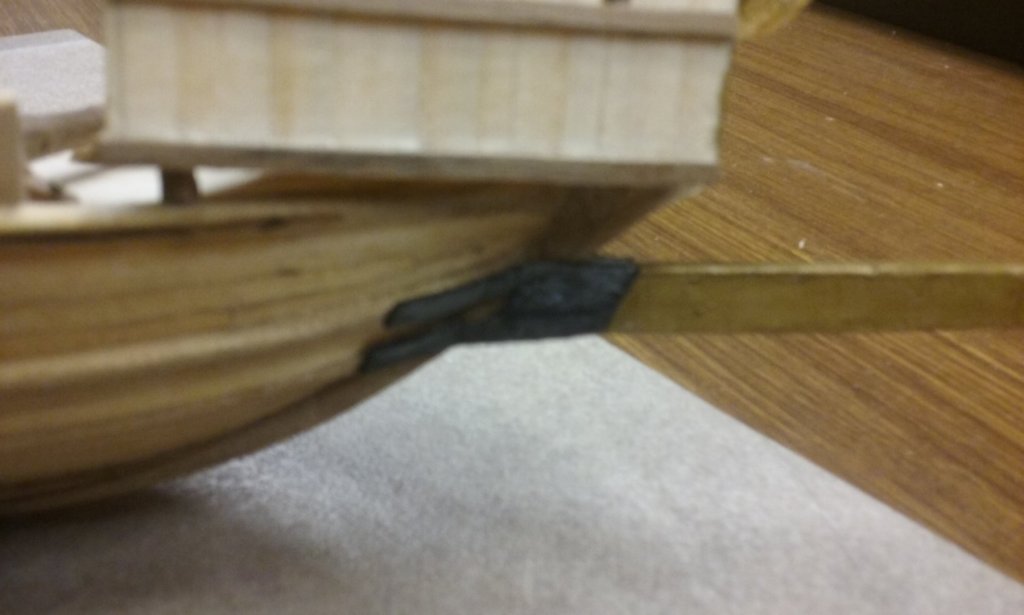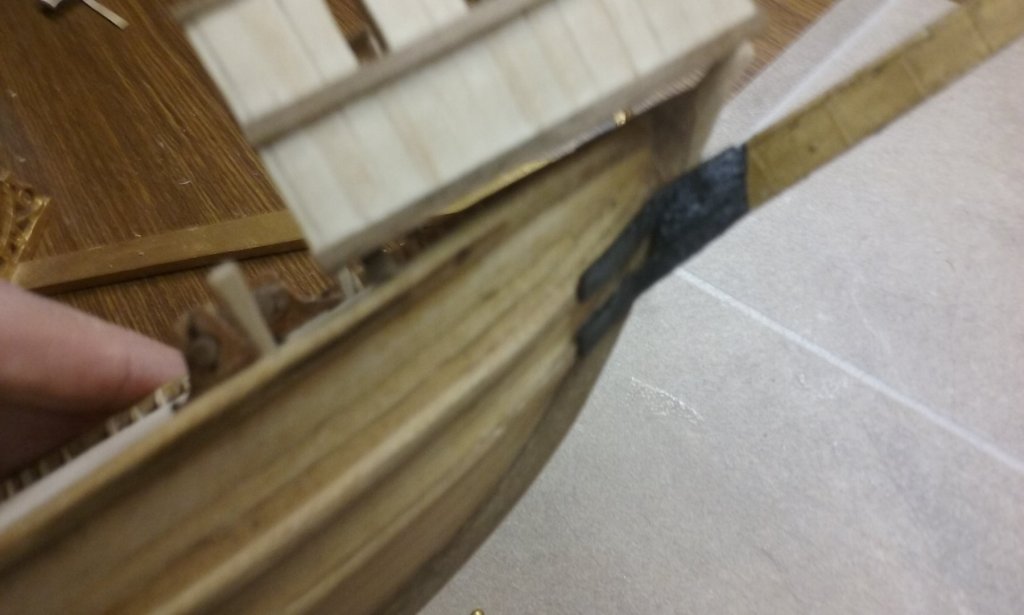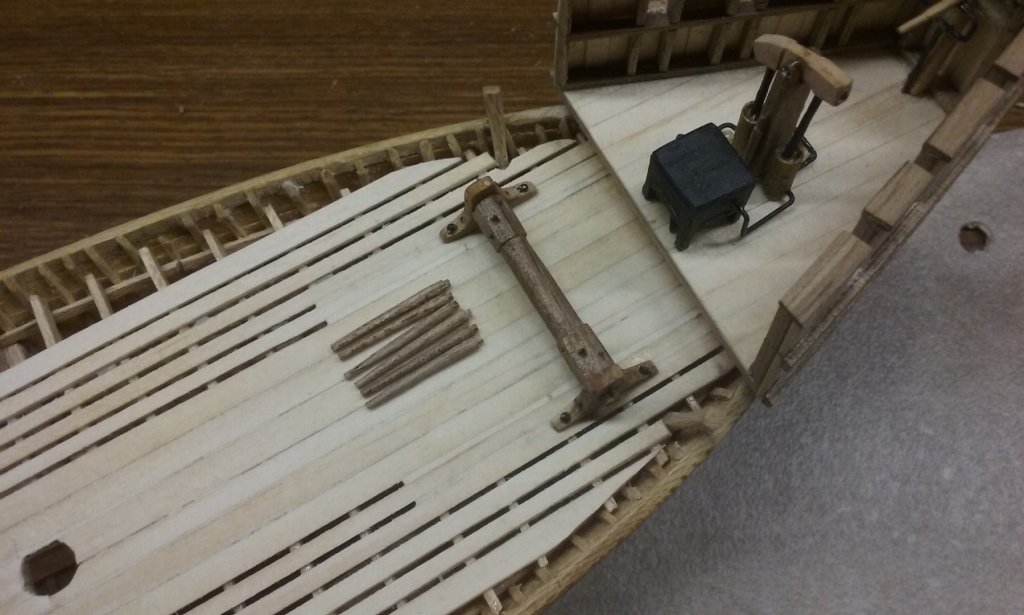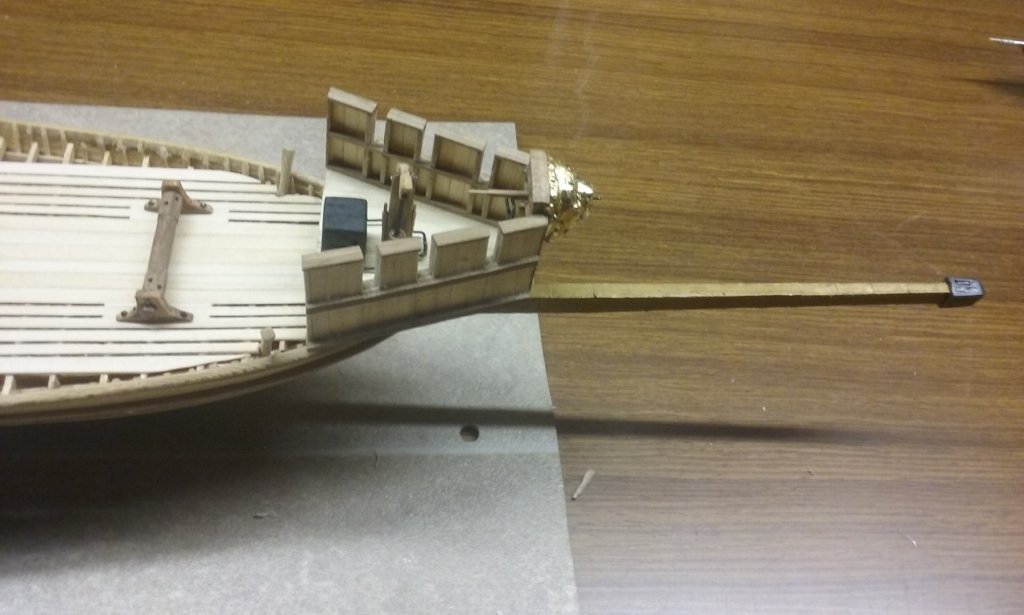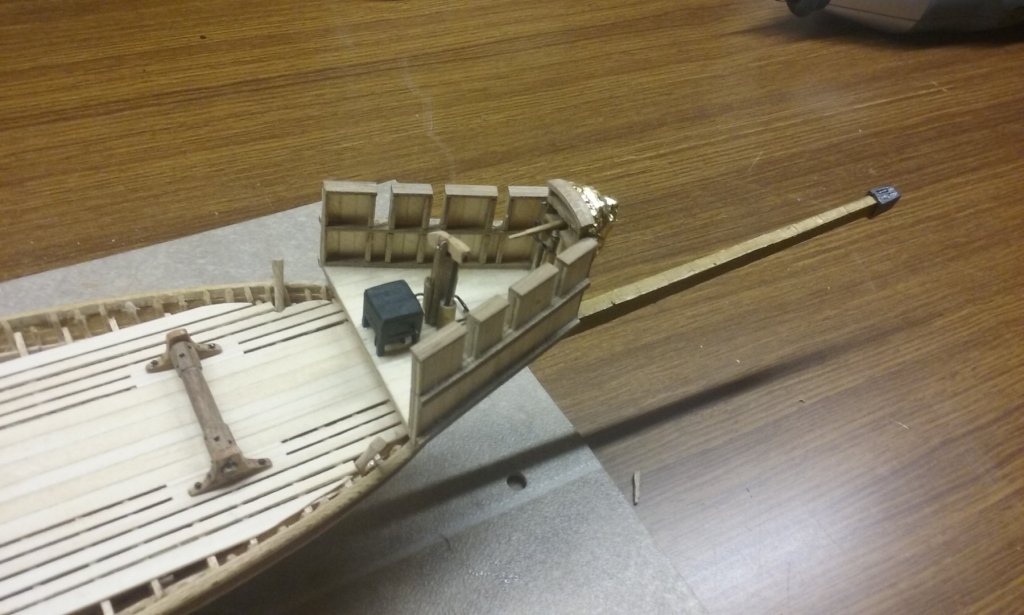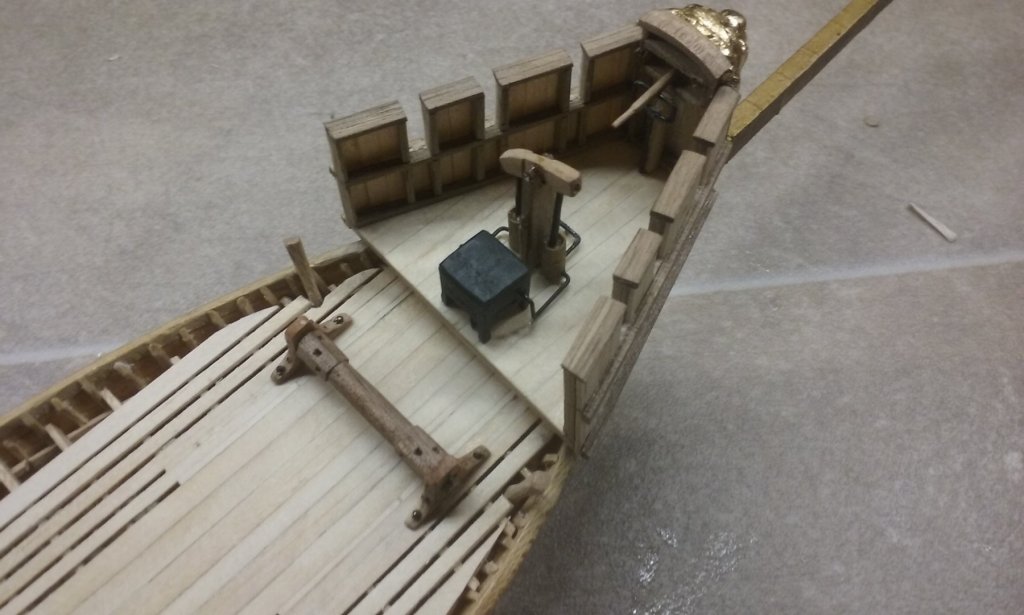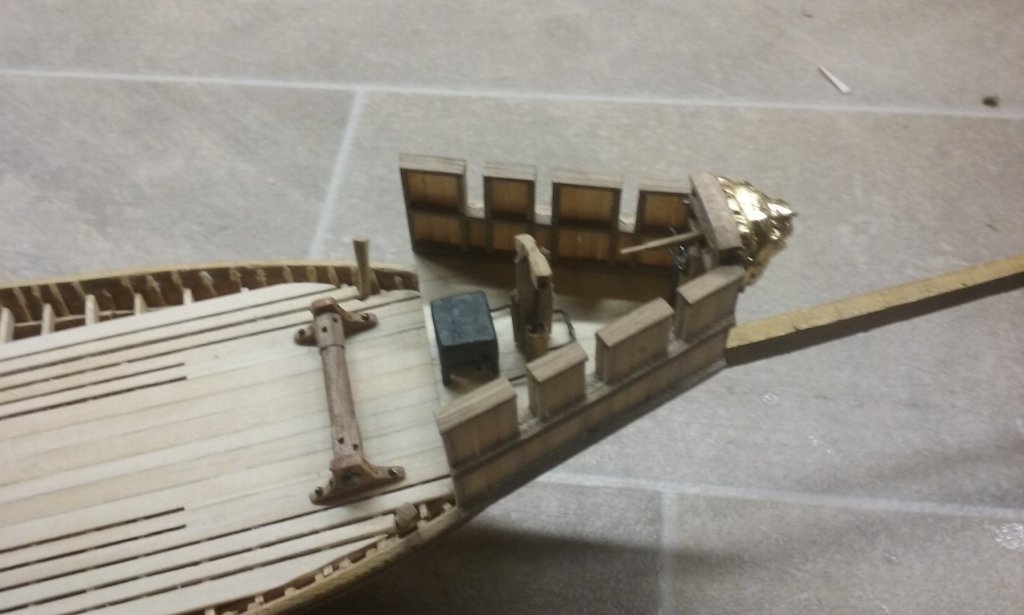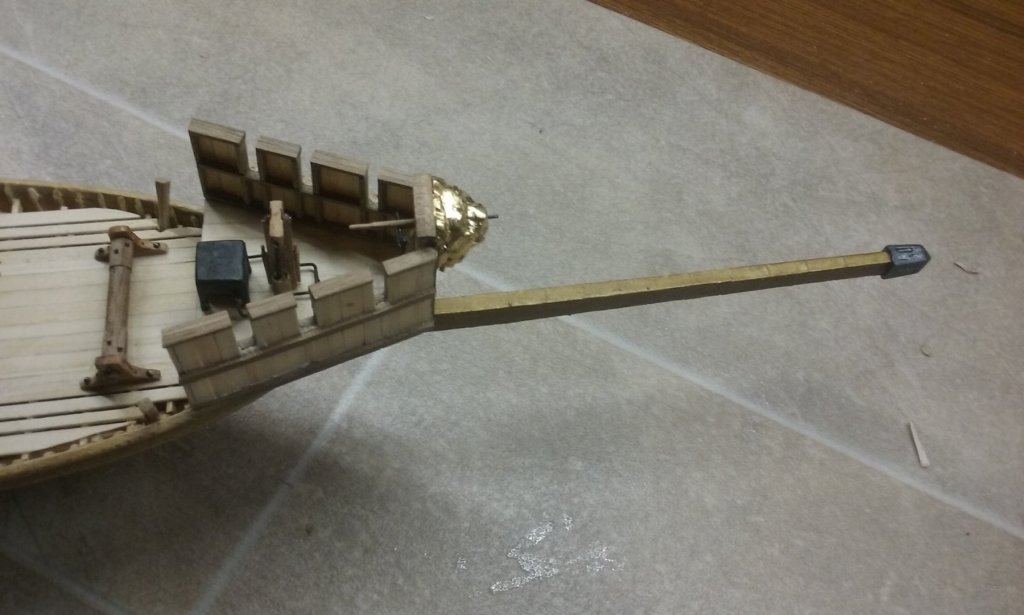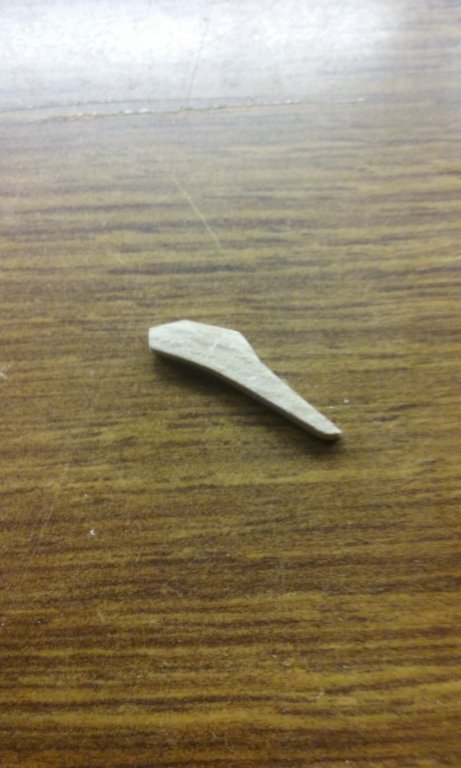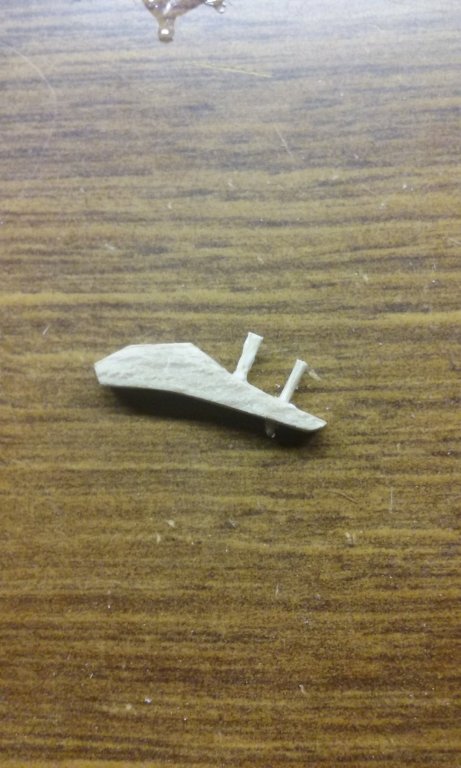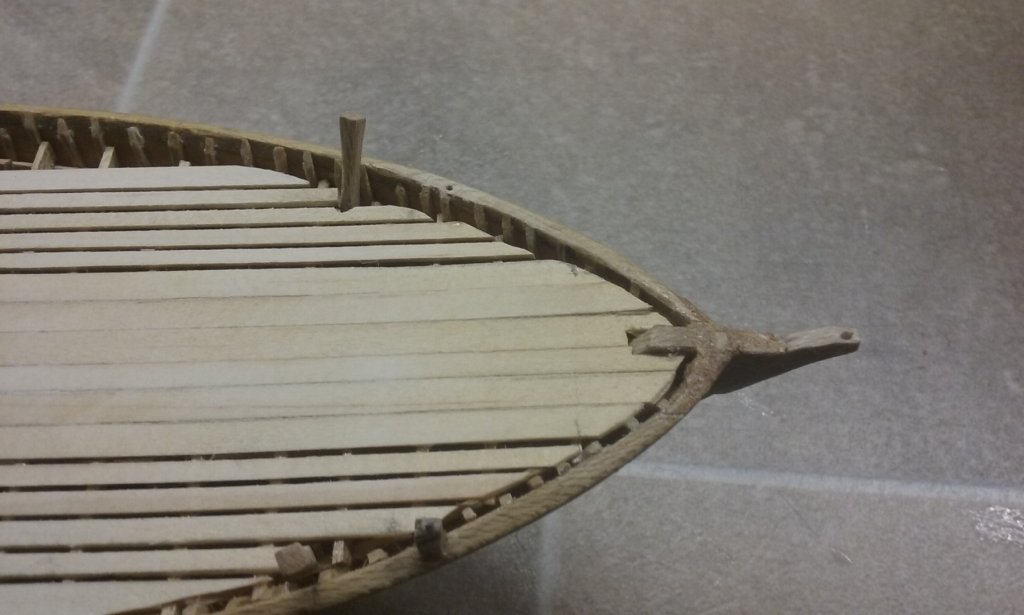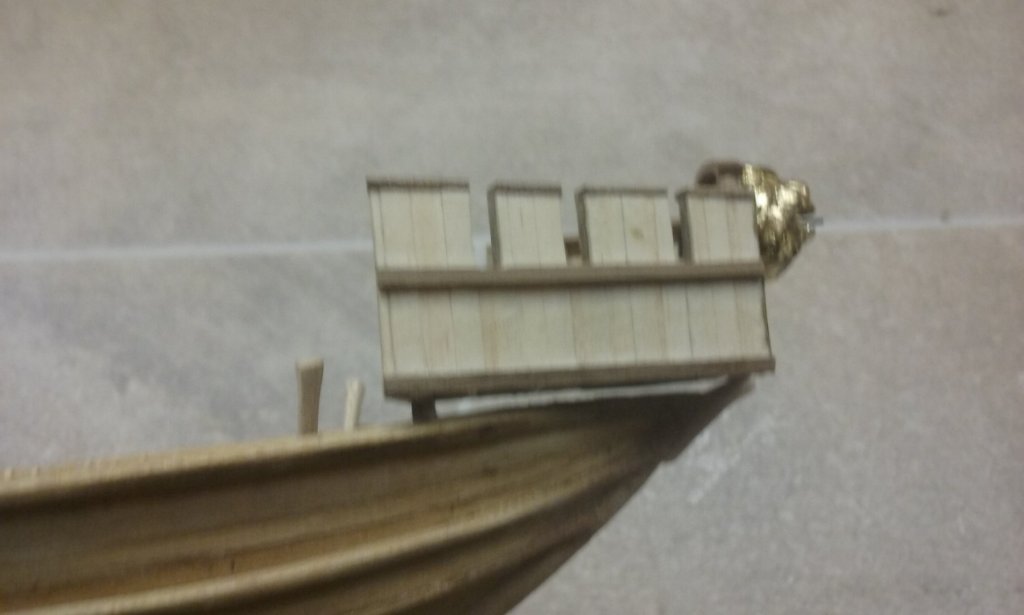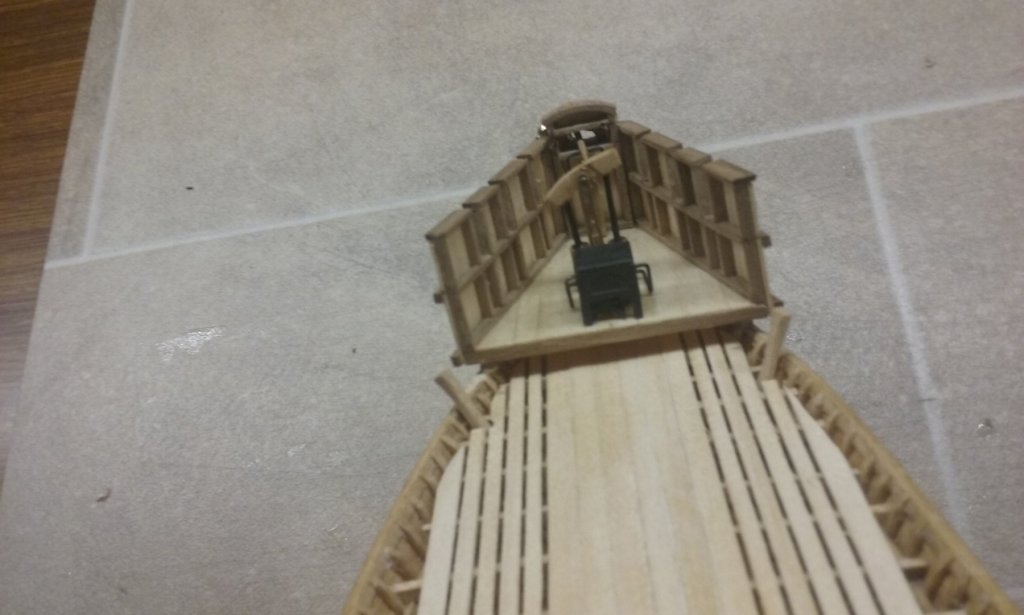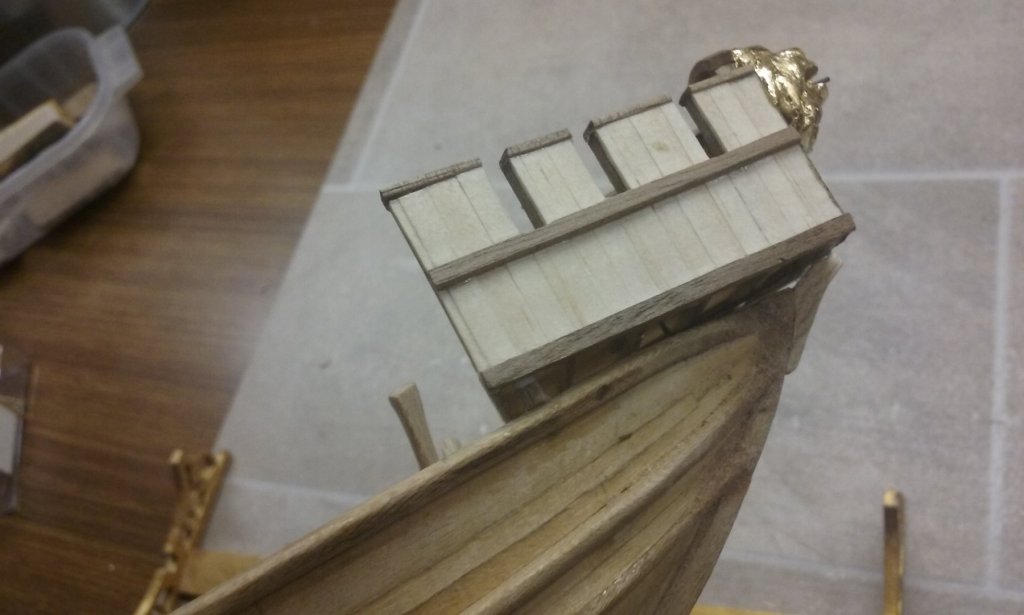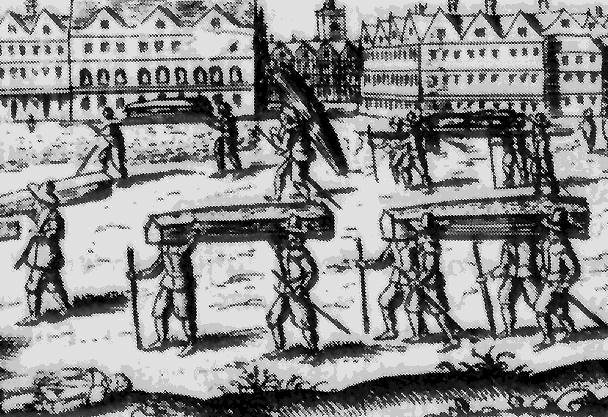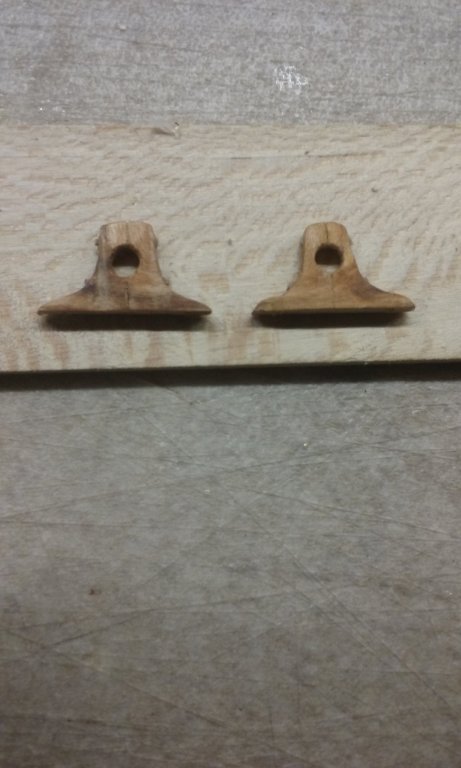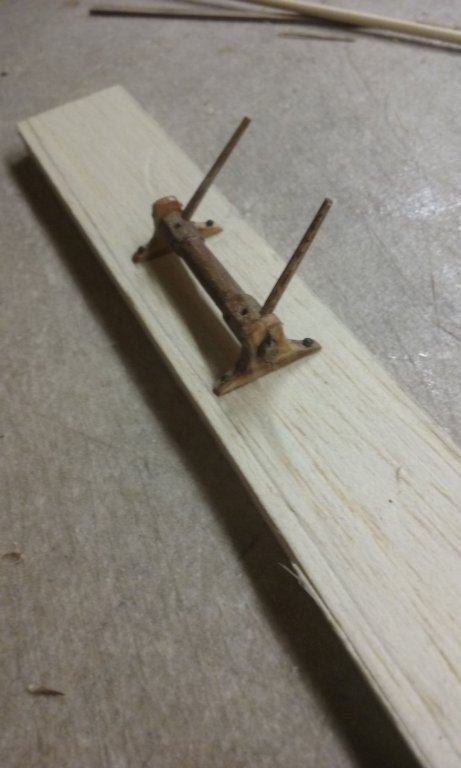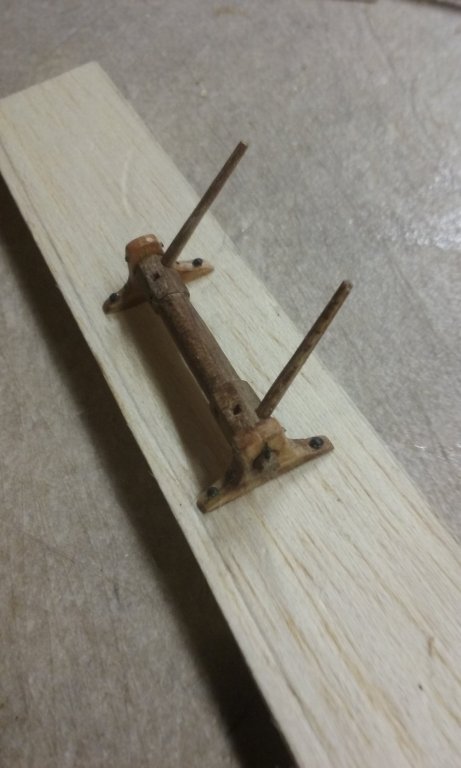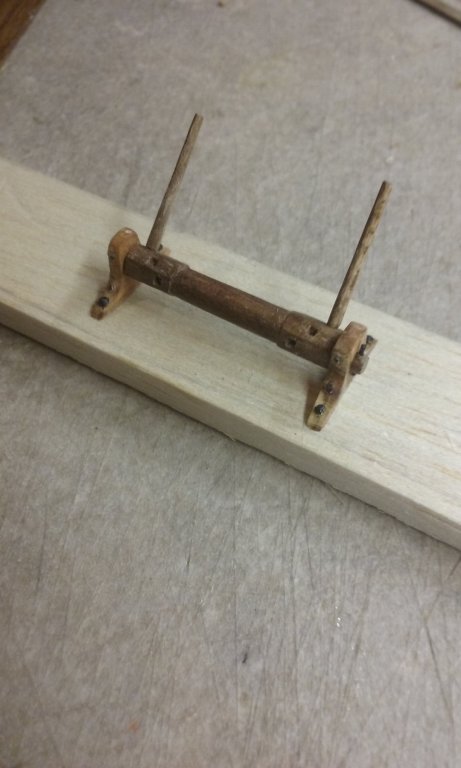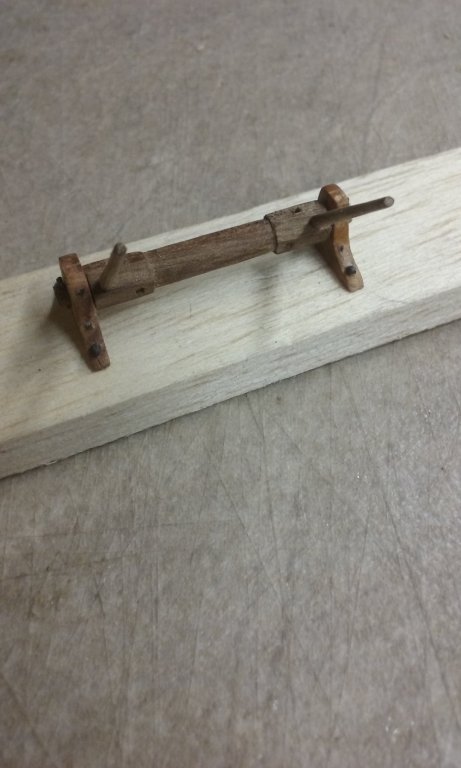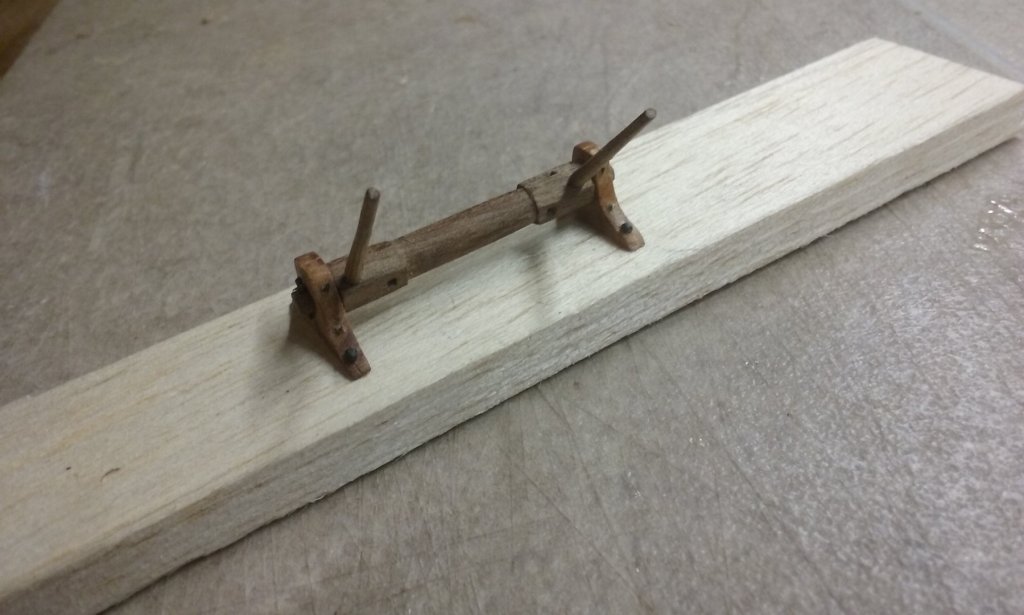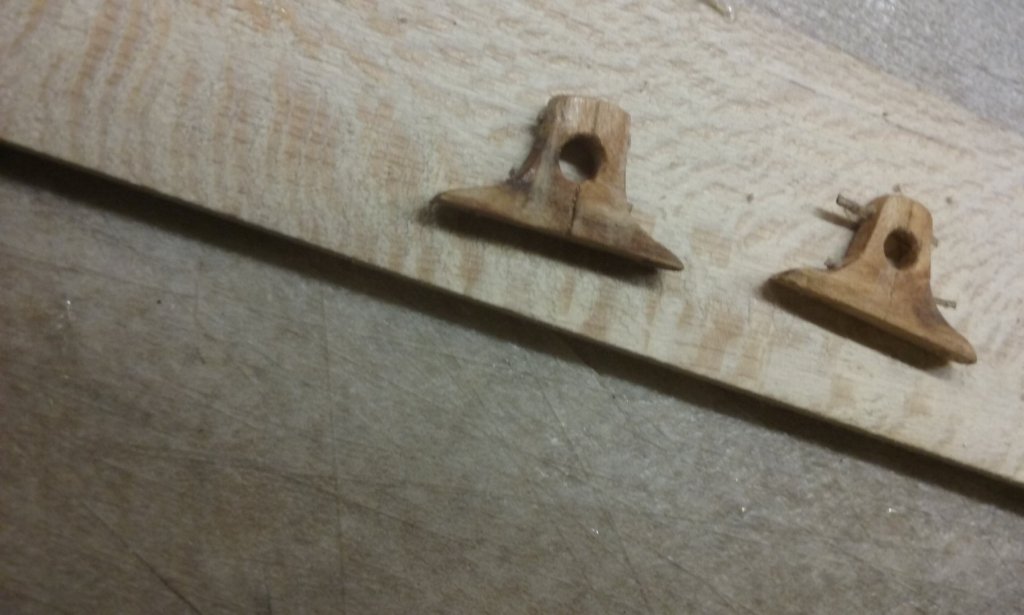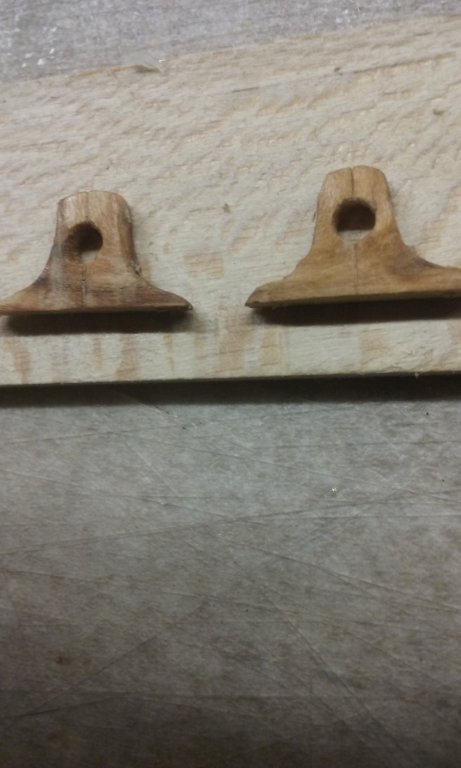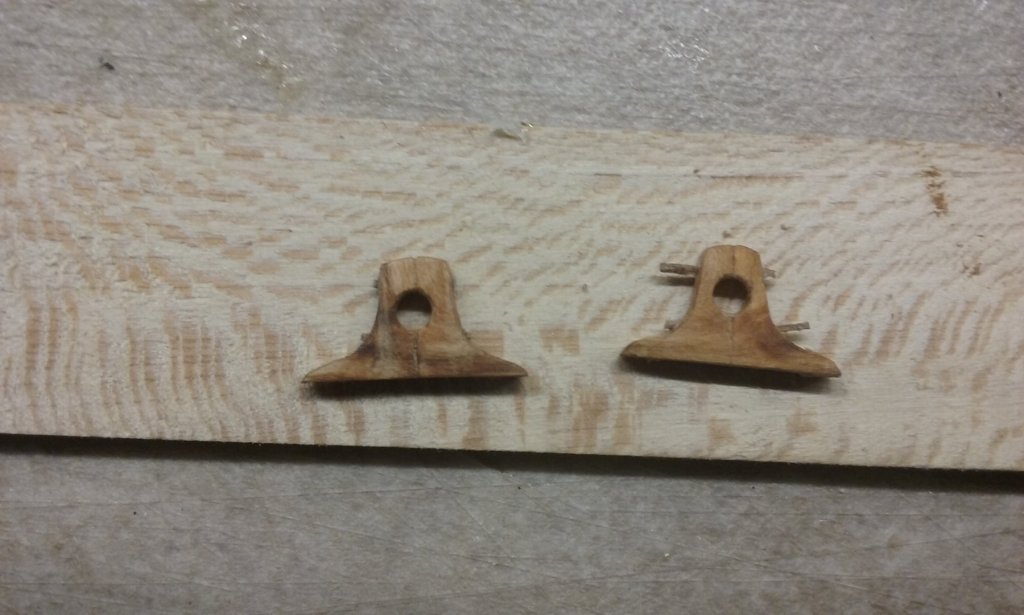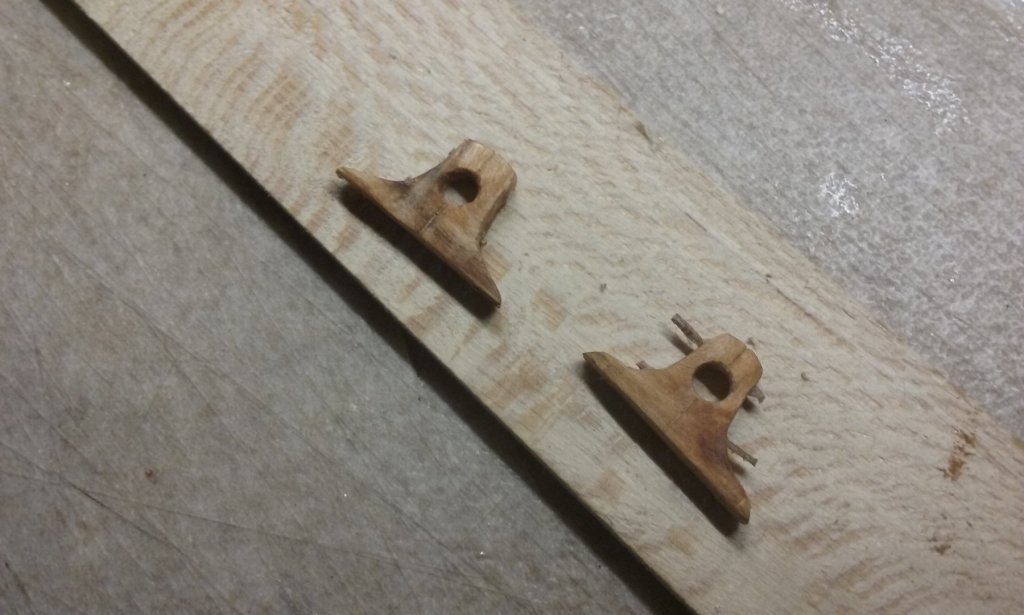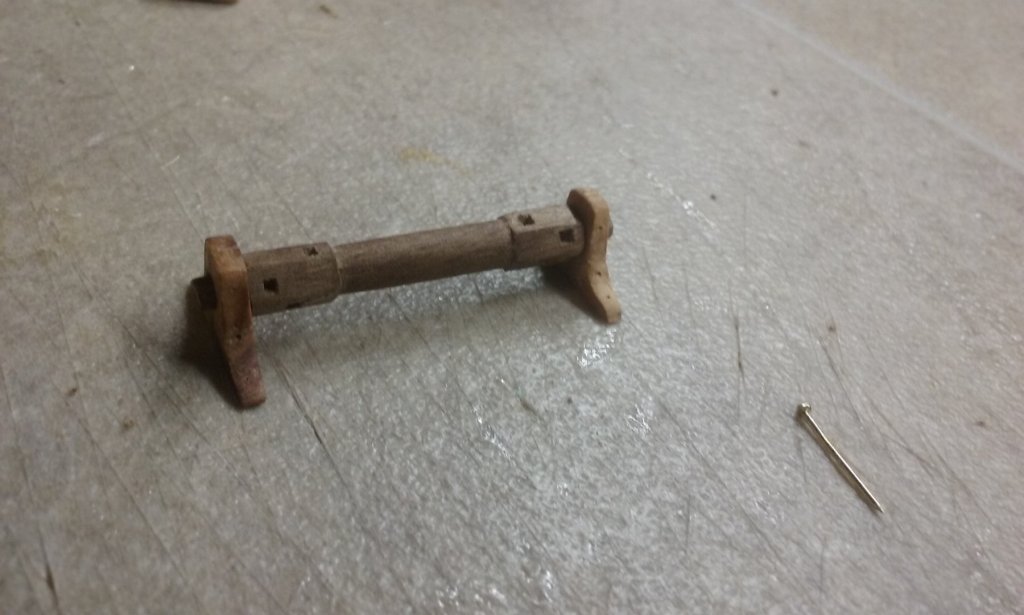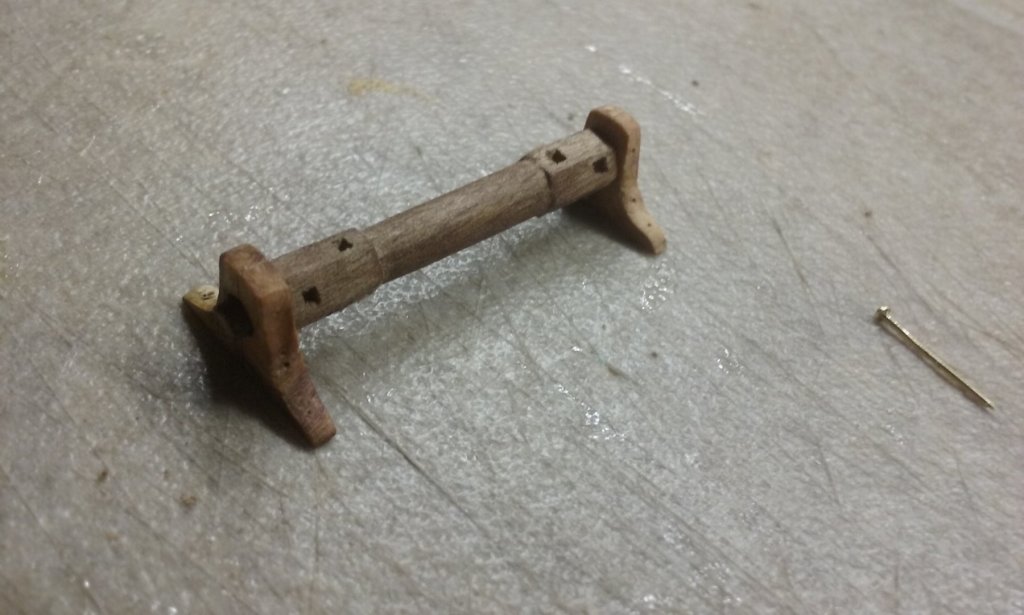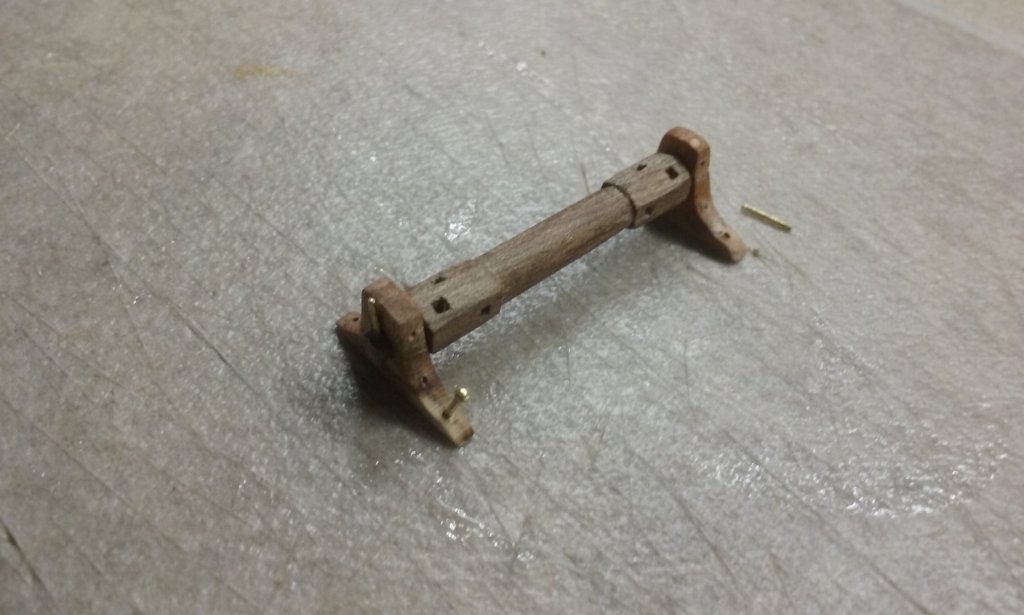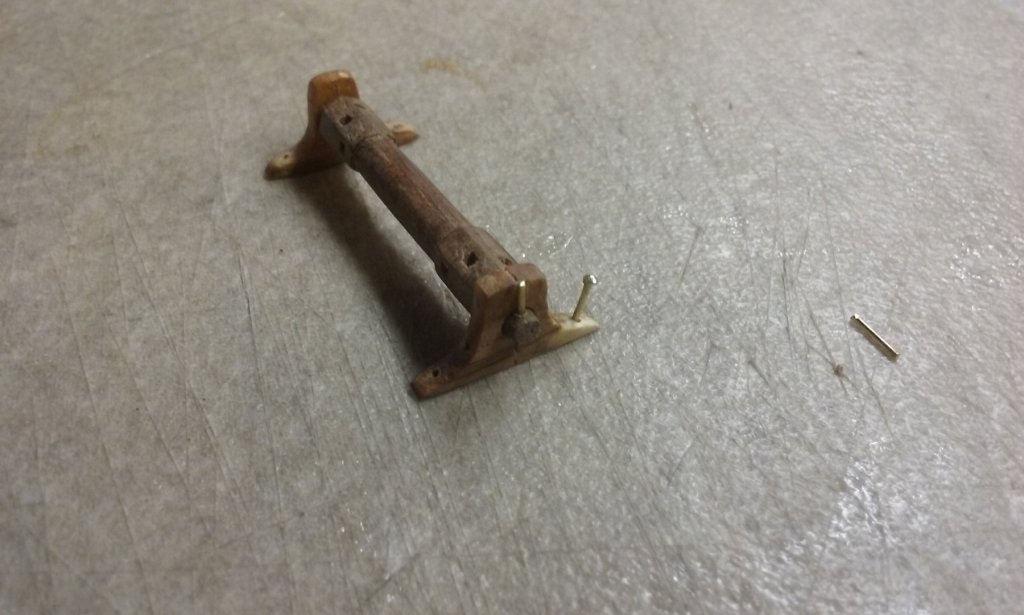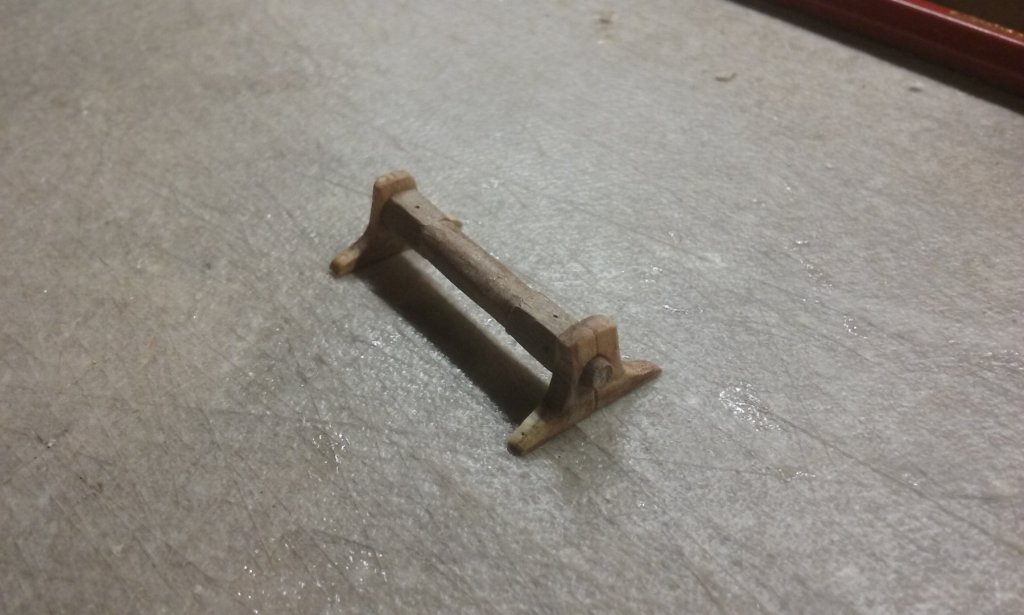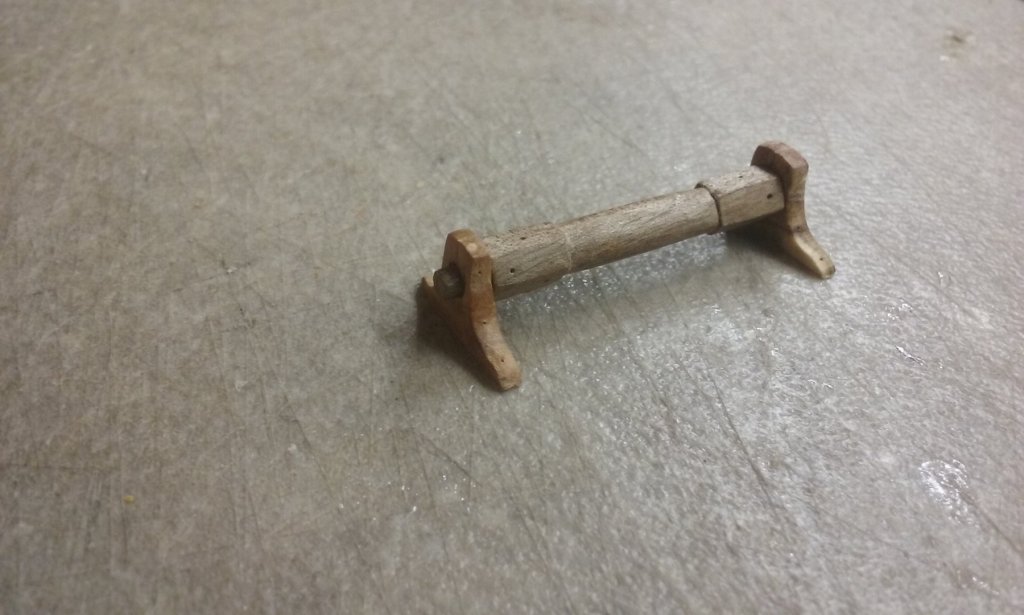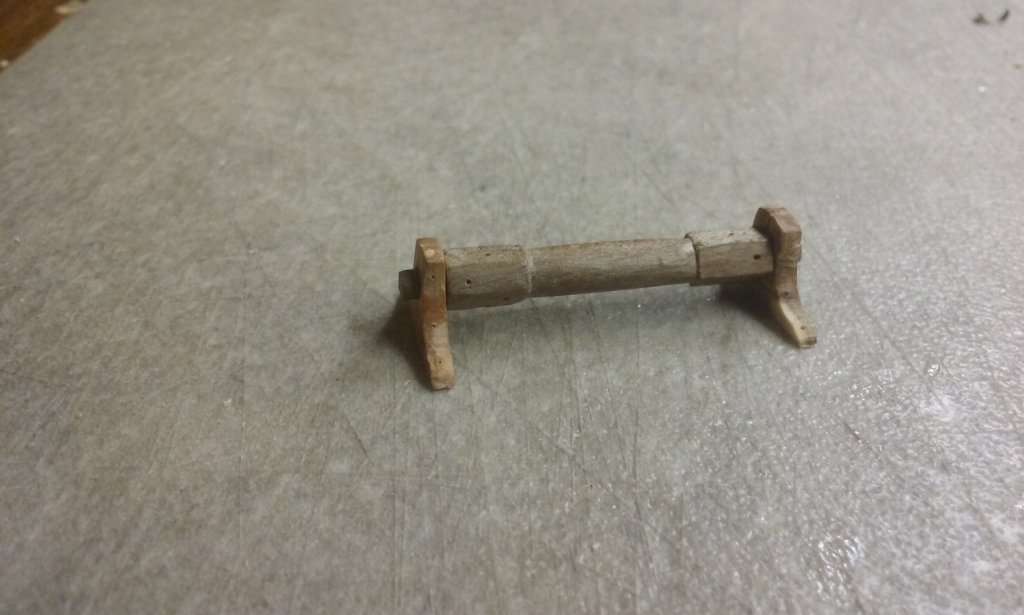-
Posts
7,985 -
Joined
-
Last visited
Content Type
Profiles
Forums
Gallery
Events
Everything posted by Louie da fly
-
I've attached the "iron" (really cardboard) brackets for the spur and painted them to look like iron. First, a coat of black Then a thin layer of silver to make it look a little more metallic. I thought of doing some rust, but this is the Emperor's ship, and anyway the model represents it in brand spanking new condition. Here are the bars for the windlass all done. Still got to find somewhere to stow them when not in use. I've also found a banner that looks pretty cool. Again, from the Skylitzes Chronicle (mid-late 12th century). This one has a cross on it, known as a cross pommée or pommelée (like a pommel, the knob at the end of a sword hilt, that acts as a counterweight to the blade). This must be where the flag came from for the modern reconstruction painting that Nikiphoros posted earlier, but I notice they changed the pink to red - not manly enough, perhaps?). Still not sure if I'm going to use this one or the one on the ship in an earlier post, where everybody's hair is blowing in the wind . . (thinks: that would be a good name for a song . . .😉) [Edit] Can any native Greek speakers make out what the word is next to the group carrying the banner? It appears to be narakagoi, or perhaps oi rakynoi? (allowing for the 12th century handwriting), but I'm really not sure, particularly about the last few letters. I don't want to use a banner that turns out to be used by someone not Byzantine. [2nd edit] The word turns out to be "sarakenoi" = saracens, so obviously I can't use it. But so, why are muslims using a banner with a cross? All getting converted? Perhaps the artist just wasn't really thinking . . . Steven
-
Beautiful work, Dick. I stand amazed at the thoroughness of your research and your ability to translate it into real-world modelling. Steven
- 263 replies
-
- nave tonda
- round ship
-
(and 2 more)
Tagged with:
-
How did I miss this until now? Very impressive, Peter. And very fast work without sacrificing quality in the slightest. At the beginning of the build you commented on whether or not you had put the log in the right place. I assume that's because you're not building the model exactly the same as the kit, with no rudders etc. No problemo - that's what we call kit-bashing, and is usually better than how it comes in the kit because the builder has invested more care and attention - and research - into it than the kit manufacturers were prepared to. I don't usually follow modern builds - I'm more a mediaeval/renaissance guy - but this build is really beautiful. Steven
- 35 replies
-
- fairmount alpine
- billing boats
-
(and 1 more)
Tagged with:
-
I'd agree with you - those floorboards look too far apart. I think moving them closer together would be an improvement. I can't see part 18 anywhere, so can't help with the balustrade. Maybe some pictures of the problem? I've got Roth's book and you're right, it does have its limitations. It was written over 30 years ago, and things have changed a lot in that time. The build is looking very good. I'm looking forward to seeing more . . .
-
A very nice collection, mate. keep up the good work. Steven
- 73 replies
-
- mediterranean
- galley
-
(and 1 more)
Tagged with:
-
Thanks everybody for the likes. It does help getting them, particularly when things get difficult (such as when I discovered I couldn't have the full complement of upper oarsmen😠). Druxey, yes I'd already thought of that, and I sheathed the spur in fake copper alloy sheeting. (Archaeologists used to call this stuff bronze, but they discovered its chemical composition was so variable that it could just as easily be called brass, so they changed the name). Mine is made of aluminium foil from the little containers the cat food came in, then painted with Humbrol "bronze" paint. Not sure if it's because it was an old tin (I bought it from a toy shop) or the fault of the paint itself, but it was very gluey and unsatisfying. However, it did the job. The front surface of the forecastle is also sheathed. John Haldon's 2006 experiment with it made it very obvious that heat shielding was absolutely necessary, and you could see from the video that a spur would have got covered with the flaming stuff. Steven
-
Thanks for the likes and comments. Nikiforos, the picture is a "13th-century manuscript illustration of a scene from the 11th-century First Crusade. Within the initial 'E' is a ship carrying the Italian-Norman nobleman Bohemund of Taranto (c.1058-1111), and Italian bishop Dagobert of Pisa (died 1105), as they sail for Apulia in Italy. Bohemond was one of the leaders of this first crusade by Christian Europe to gain territory in the Holy Land. Bohemund founded a Norman monarchy in Antioch. Daimbert, with Bohemund's support, became Latin Patriarch of Jerusalem. The text is Old French. Artwork from a 1250s French edition of 'Histoire d'Outremer' by medieval chronicler William of Tyre (c.1130-1186)." I've installed the windlass - twice. The first time it was too far aft and didn't provide enough room for the first oarsman or two. So I dissolved the glue with isopropanol and drilled some more holes in the deck for the pins, and moved it forward, closer to the pseudopation (forecastle). It looks a little cramped for access to the pseudopation, but hey, it's a ship and sailors are good at getting into small spaces and around obstacles. I've also finally glued the spur in place on the bow. The model is getting complete enough to do this at last. I have yet to install the cardboard brackets which represent iron ones, connecting the spur to the wales either side of the bow. Probably in the next post. And I need to find a good place to stow the windlass bars, and make a couple of little ladders for the crew to access the pseudopation either side of the windlass. Lots of little details still to do before I can do things like add the lower oars, masts etc. And I've yet to summon up courage to make the 50 upper bank oarsmen. In fact, due to designing as I went along, there'll be only 44 of them because the poop deck ended up longer than in the original drawings, which didn't allow enough room for the "tent" and the steersmen. With the longer poop I've had to sacrifice the last three pairs of upper oars aft. Not much I can do about it so I just have to live with it. If I ever did a dromon Mark II I'd allow for this and make the ship just that bit longer, but it's not worth doing just for that. Steven
-
Hi, I just came across this link which I hope is of interest. http://clandonald-heritage.hmstudiosllc.com/the-galley/ It's Scottish rather than Irish, but you might find it useful, particularly the sculpture with the ship on it. Unfortunately, there's no information on the date or origin of this artefact, but it's certainly very interesting.The towers on the castle look 14th century to me, and if the thing above the ship is a helmet, as I believe it to be, it is of a type (known as a barrel helm)which began to see use about 1250 and stayed in use for about 100 years. The text is rather partisan, and probably should be taken with a pinch of salt. But it brings up several references to Gaelic galleys before the advent of the Vikings. Oh, and following up on the seal shown in the above article, I discovered another link, with even more pictures of, and information about Gaelic (specifically Scottish) galleys - https://en.wikipedia.org/wiki/Alasdair_Óg_of_Islay And following up on Pinterest, some more pics, at https://www.pinterest.com.au/pin/92112754860158326/ and if you click on the more interesting images they take you to subsequent pages with more ships of the same type. Hope this helps, Steven
- 27 replies
-
- irish galley
- galley
-
(and 1 more)
Tagged with:
-
Greg, that's already looking good. I'm looking forward to another of your amazing builds. By the way, what size drill bit did you use for all those holes? Steven
- 345 replies
-
- graf zeppelin
- trumpeter
-
(and 2 more)
Tagged with:
-
Looking really good, George. The quality of work, particularly at such a small scale, is really impressive. Steven
- 90 replies
-
- bomb ketch
- pyro
-
(and 1 more)
Tagged with:
-
It's very annoying to have to re-learn lessons you thought you'd already learned. In this case - butt-joints aren't strong and will fail at the most inconvenient time! I supported the forecastle on two uprights set into the corners of the forecastle substructure (underneath) and standing on the gunwale with butt-joints. I was working on the third support, a knee attached to the stempost, when I knocked the forecastle and it came off! One upright stayed with the forecastle, the other stayed with the gunwale. So I've had to re-jig it all and put pinned joints in place of the butt joints. And to head off future disasters I've made pin-joints between the knee and the stempost. Serves me right for taking the "easy" way out. Actually, it's just as well because the forrard part of the forecastle was too low - it was resting on the delivery pipe for the Greek Fire siphon instead of allowing a small space below it. So, all good, but I should have done it right the first time😠. Steven
-
And Nikiforos is "the bearer of victory". Rather appropriate, I think. Regarding AL - well, I've never made a wooden ship from a kit, so haven't had any dealings with them. Sorry to hear about the problem with the plans, but I think Mark's advice is good. And that you're kit-bashing means you're already half-way to the Dark Side (scratch-building) . . .😉 Steven
-
Nikiphoros, what you've done so far looks good. The lack of plans is a bit of a problem - have you been in touch with AL to let them know they're missing? I should think they'll send them to you if that's the case (though I haven't any experience with them, I believe they're a reputable company and should be willing to help). I couldn't find the Web reference to the Caboteur nomme Sambouck that you mentioned. Do you have a link I could click on to find it? Just as a heads-up before you start making one, as far as I'm aware coffins at that time were shaped like this wider at one end than at the other, and with a lid like a "gabled roof". You may be able to re-arrange the contents of the boat so the mast won't have to be shifted, which is what I think they'd have done at the time. Otherwise the boat just won't be able to sail - the wind forces will be out of balance. Keep up the good work. Looking forward to further progress. Steven
-
Yes, not problem, and certainly not irretrievable. As I understand it, this is the first layer of planking, so after a bit of bog and sanding, you get a second go at it, and can make it better in light of your experience first time through. I stuffed up (in my own opinion) on my dromon planking and it didn't have a second layer so I was stuck with it. But in the long run it wasn't as bad as all that and I was able to accept it and move on, and determined to do better on the next build. Steven
-
Thanks for all the likes and the supportive comments. Here is the windlass; End pieces with fake bolts inserted. I made hem out of carved bits of wood: Then cut them off to just show the "bolt heads". The bolts to fix the windlass to the deck are made, painted and in place. Bars made and in place, and "bolt heads" painted black. All ready to put in place on the deck of the ship. As the windlass won't be in use, I'll be putting the bars in "storage" when the ship is on display. Steven
-
More progress on the windlass. I've cut the square holes for the bars, and drilled holes for the pins/bolts holding the windlass to the deck. These will be made from tiny brass pins I got years ago - can't remember where, and I've no idea where I'll be able to get replacements if I need them again). As I can't get drill bits bigger than 0.38mm (too small) or smaller than 0.8mm (too big), I used one of the little pins as a drill bit. It's got a sharp pyramidal head which acts quite to drill holes. I've used it to drill the holes for the fake bolts holding the frame together, plus the ones in the ends of the spindle for the pegs to keep it in place. The pegs will also be made from brass pins; I'd intended to use them for the fake bolts as well but it's all too fiddly and I've decided instead to use wood or bamboo painted to look like iron. Steven
-
That's a beautiful model, beautifully executed. Strange that the tower was so disliked by artists and architects when it was first built, as to our eyes it is a thing of beauty. But the writer Guy de Maupassant hated it so much he always ate lunch at the base of the tower, because it was the only place in Paris from which he couldn't see it. I've been up to the first level, but no higher (I chickened out). Steven
-
I don't know the answer to your question myself, but it would help others answer it if you specify the geographical area and time period (probably only to the nearest century) you wish to know about. There is certainly information available on the subject, but I'm not the one with the information to hand. Steven
-
I take my hat off to you, sir. That is some seriously beautiful work. Steven
- 589 replies
-
- le gros ventre
- cargo
-
(and 1 more)
Tagged with:
-
Actually, I think it's me that's derailing my own thread. Must get back to the build log. Here's current progress on the windlass. I think the central section of the "barrel" needs a bit of work to make the shape more consistent. It seems to be bulging outward a bit in the middle. Now I have to put in the square holes to take the bars and some way of fixing the windlass to the deck - probably pins of some sort - plus fake bolts holding the halves of the housing together. On the photos you can see the pilot holes for them. Speaking of which, some breaking news - I managed to buy 0.38mm drill bits in Ballarat! Amazing! Unfortunately I don't have a precise enough drill mechanism to use them . . . (Note to self - must add to wishlist . . . ). I've also done up a spreadsheet for myself with a sequence of the next things to do/make, so I don't do stuff I then have to undo because it gets in the way of doing something else. In particular, things that can be done before I glue the lower bank of oars in place, and things that will have to wait till afterwards. Steven
-
Oh, there's still any amount of guesswork and speculation involved in this model. Questions to which there are no known answers and never likely to be. But without a time machine, there's nobody who can tell me my guesses are wrong . . . Yes, the history of Armenia is fascinating, particularly Cilician Armenia. When I was doing mediaeval re-enactment - portraying a Varangian in Imperial service - I researched several of the neighbouring cultures which Byzantium encountered, including Armenia, for the benefit of my fellow Varangian re-enactors, and put up a web-page with what I'd found - http://www.angelfire.com/empire/egfroth/Armenians.html . It's only a rough overview and many of the pictures have vanished, but it gives some idea of what a vital and interesting culture they had. Steven
-
I'm trying to get this as accurate as possible for both time and place. For example, though it certainly has its qualities, the model on the postage stamp that Messis so kindly sent an image of does have a couple of anachronisms - - the CHI ROH (X and P superimposed) symbol on the after sail is too early for a middle Byzantine dromon and the cross with the repeated letter B is too late. However, these things are probably only important to picky people like me.😉 Steven
About us
Modelshipworld - Advancing Ship Modeling through Research
SSL Secured
Your security is important for us so this Website is SSL-Secured
NRG Mailing Address
Nautical Research Guild
237 South Lincoln Street
Westmont IL, 60559-1917
Model Ship World ® and the MSW logo are Registered Trademarks, and belong to the Nautical Research Guild (United States Patent and Trademark Office: No. 6,929,264 & No. 6,929,274, registered Dec. 20, 2022)
Helpful Links
About the NRG
If you enjoy building ship models that are historically accurate as well as beautiful, then The Nautical Research Guild (NRG) is just right for you.
The Guild is a non-profit educational organization whose mission is to “Advance Ship Modeling Through Research”. We provide support to our members in their efforts to raise the quality of their model ships.
The Nautical Research Guild has published our world-renowned quarterly magazine, The Nautical Research Journal, since 1955. The pages of the Journal are full of articles by accomplished ship modelers who show you how they create those exquisite details on their models, and by maritime historians who show you the correct details to build. The Journal is available in both print and digital editions. Go to the NRG web site (www.thenrg.org) to download a complimentary digital copy of the Journal. The NRG also publishes plan sets, books and compilations of back issues of the Journal and the former Ships in Scale and Model Ship Builder magazines.



